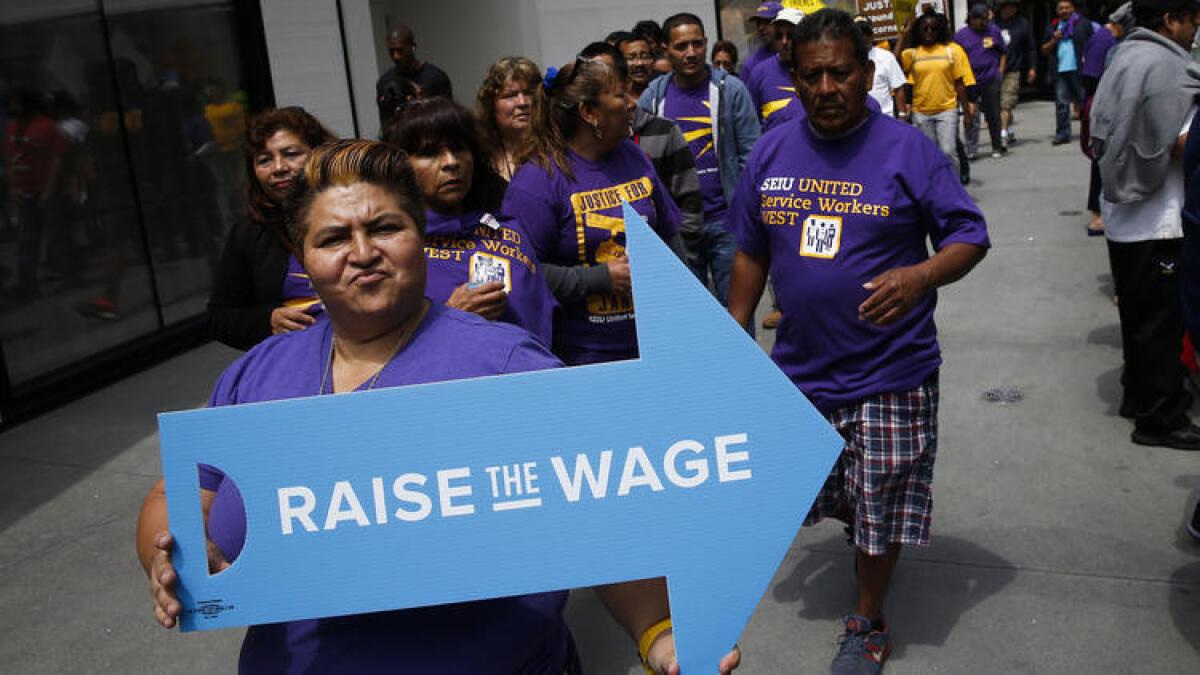Rival labor-backed minimum wage measures could appear on 2016 ballot

SEIU workers march in downtown Los Angeles earlier this year for a higher minimum wage.
- Share via
The fractious internal politics of one of California’s most powerful unions spilled into the movement to raise the statewide minimum wage Tuesday, as one wing of the Service Employees International Union announced a proposed ballot initiative that would compete with a measure backed by another branch of the labor group.
The new proposal, led by the SEIU State Council, would be broader in its scope than a separate wage initiative proposed by SEIU-United Healthcare Workers West. Both measures would raise the minimum wage to $15 an hour, but the State Council’s proposal would also double the amount of mandated paid sick leave for Californians and extend sick-leave rights to workers not currently covered under state law.
------------
FOR THE RECORD
An earlier version of this post identified a spokesman for the SEIU-UHW union as Sean Wherley. The spokesman quoted is Steve Trossman.
------------
Each group is aiming to place its proposal on the November 2016 ballot. SEIU leaders and activists with the national “Fight for $15” campaign — which has sought to raise pay for fast-food workers nationwide — announced the latest proposed ballot initiative in a Tuesday conference call with reporters.
“It will change my life and my family’s life,” Alaina Brooks, a home healthcare provider in Los Angeles County, said of the proposed measure during the call. In addition to increased pay, Brooks said that more paid leave would give her “peace of mind knowing that when and if I get sick, I can take time off to get better.”
Yet the announcement is likely to be controversial, presaging a power struggle on the left over who will control and claim credit for what could be a landmark victory in the effort to raise pay for the working poor.
The placement of dueling minimum-wage proposals on the ballot also runs the risk of diluting support for both measures and creating the sort of voter confusion that can be fatal for ballot initiatives.
Larry Gerston, a professor emeritus of political science at San Jose State University, said that while strong support exists in California for a statewide minimum-wage increase, “all bets are off” with the prospect of two ballot measures.
“With competing initiatives, there’s a very strong possibility that the voters will be so confused that they’ll vote ‘no’ on both. We’ve seen it before,” Gerston said. “The opponents will be delighted, because the proponents will be spending all their time convincing voters that ours is better than the other.”
Officials with the State Council and SEIU Local 1021 — which represents 54,000 Northern California service workers and is supporting the new ballot proposal — said they plan to negotiate with the proponents of the rival initiative and hope to eventually agree on a single minimum-wage measure that would appear on the ballot next year.
However, they also signaled their willingness to go their own way if an agreement cannot be reached.
“We are doing our own thing, because we think this initiative is sufficiently different,” said Kristin Lynch of Local 1021. “We’re prepared at this point, with our coalition partners, to put in the $20 million to $30 million we need to make this a winning initiative.”
Steve Trossman, a spokesman for the campaign for the original SEIU-backed proposal, the Fair Wage Act of 2016, said SEIU-UHW officials support the new measure’s effort to expand sick days but worry about weighing down a minimum-wage initiative with other policy changes.
“Our experience is that every time you add a level of complexity to a ballot initiative it creates new challenges,” Trossman said. He said it was premature to speculate on the potential effects of having two minimum-wage initiatives on the ballot.
Trossman said UHW officials have already surpassed the 366,000 petition signatures needed to qualify their measure for the ballot. That proposed initiative would increase the state’s minimum wage by $1 each year until it reaches $15 in 2021, with annual increases afterward tied to inflation.
San Francisco Mayor Ed Lee and Oakland Mayor Libby Schaaf are chairing the campaign for the SEIU-UHW proposal, which has also been endorsed by Lt. Gov. Gavin Newsom — widely considered a top contender in the 2018 governor’s race, for which he is already campaigning — and state Controller Betty Yee.
The rival proposal announced Tuesday, tentatively titled the “Raise California’s Wage and Paid Sick Days Act of 2016,” is more complex, calling for major changes to the state’s sick-leave policies. The measure would require employers to allow workers to take six paid sick days each year instead of the current three, and extend those protections for the first time to home healthcare workers.
It would also accelerate the timeline for boosting the state’s minimum wage, reaching $15 an hour in 2020 while giving businesses with 25 or fewer employees an extra year to comply. The UHW-backed proposal would raise the minimum wage to $15 in 2021 for all workers.
The state attorney general’s office must review the new proposal before organizers can begin collecting signatures to qualify it for the 2016 ballot.
Twitter: @petejamison
More to Read
Sign up for Essential California
The most important California stories and recommendations in your inbox every morning.
You may occasionally receive promotional content from the Los Angeles Times.














